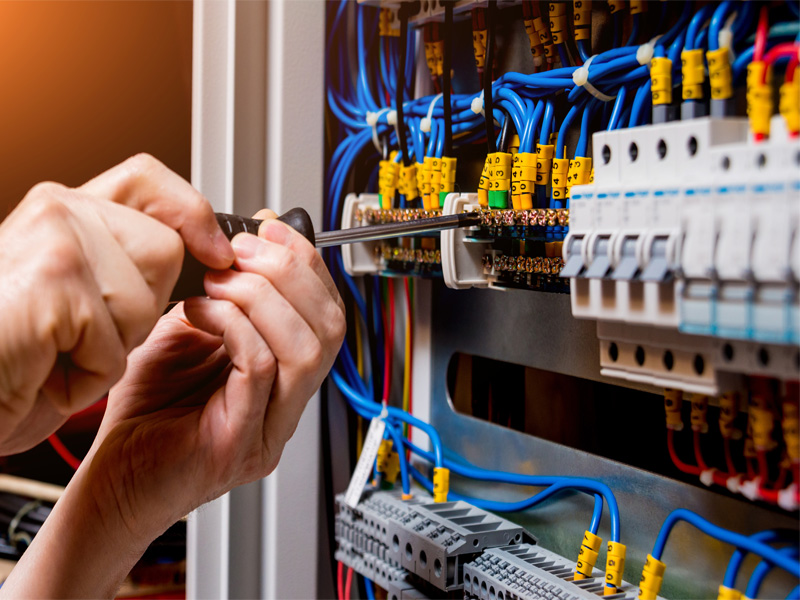Contact : +919448515139
Internal Electrification Work
Internal electrification work refers to the installation and maintenance of electrical systems within a building, ensuring the safe and efficient distribution of electrical power throughout the structure. It involves laying electrical cables, installing outlets, switches, lights, circuit breakers, and connecting appliances to the power supply. This work is typically carried out by licensed electricians and is crucial for residential, commercial, and industrial buildings. Proper planning, installation, and testing are vital to ensure the safety and reliability of the electrical system.
Key Components of Internal Electrification
-
Wiring and Cabling: The foundation of internal electrification is the wiring system. Electric wires, typically made of copper or aluminum, are used to carry electricity from the main power supply to various outlets and devices. These cables are categorized based on their capacity and usage, such as power cables, control cables, or communication cables. Proper selection of cable size is crucial, as undersized cables can lead to overheating, while oversized cables can be unnecessarily expensive.
-
Electrical Panels and Circuit Breakers: The electrical panel, often referred to as the distribution board, acts as the heart of an electrical system. It distributes power from the main supply to various circuits in the building. Circuit breakers are installed within the panel to protect the system from overloads or short circuits. In modern systems, Residual Current Circuit Breakers (RCCBs) or Miniature Circuit Breakers (MCBs) are commonly used for enhanced safety. These devices automatically disconnect power in case of an electrical fault.
-
Switches, Sockets, and Outlets: Switches control the flow of electricity to devices and appliances, while sockets provide the connection points for plug-in devices. It’s important to place outlets strategically to meet the needs of the space without overloading any particular point in the system. Sockets come in different types based on voltage, amperage, and grounding requirements.
-
Lighting Installation: One of the most visible aspects of internal electrification is lighting. The electrician installs light fixtures such as bulbs, tube lights, and LED lights throughout the building. Energy-efficient lighting systems, including LED bulbs and smart lighting, have become increasingly popular due to their lower energy consumption and longer life.
-
Earthing: Earthing, or grounding, is a crucial safety measure in internal electrification. It involves connecting the electrical system to the ground to prevent electric shocks or fires in case of a fault. The earthing system ensures that any excess electrical energy is safely discharged into the ground rather than causing harm to people or equipment.
Steps in Internal Electrification
-
Planning and Design: A proper electrification plan is crucial to ensure the system’s efficiency and safety. The layout is designed to meet the building’s electrical requirements, taking into consideration the location of switches, sockets, and light fixtures. Future-proofing, such as planning for additional power points or smart home systems, is also considered.
-
Wiring Installation: The next step involves laying the electrical wires according to the design. Wires are typically run through conduits concealed in walls, ceilings, or floors. Proper insulation and protection of the wires are vital to prevent short circuits or accidental damage.
-
Fixing of Electrical Components: After the wiring is completed, electricians install outlets, switches, sockets, and lighting fixtures. Care is taken to ensure proper alignment, secure fastening, and correct connections.
-
Testing and Commissioning: Once the installation is complete, the system undergoes rigorous testing to ensure all circuits, breakers, and appliances function properly. The electrician checks for issues like voltage irregularities, improper grounding, or faulty connections.
-
Maintenance: Regular maintenance is essential for the longevity of the electrical system. It includes inspecting circuit breakers, checking wiring insulation, testing outlets, and replacing any worn-out components.
Safety Measures and Standards
Internal electrification work must adhere to safety standards and regulations set by national and local authorities. For example, the use of high-quality materials and adherence to specific wiring practices can significantly reduce the risk of electrical hazards. Electricians must follow the prescribed guidelines for installation, especially for earthing, cable routing, and load distribution.
Additionally, periodic inspections and testing are necessary to ensure the system remains safe over time. Electrical fires, shocks, or short circuits can occur due to faulty installation, overloads, or wear and tear, making it crucial to prioritize maintenance.
Conclusion
Internal electrification is a critical aspect of any building’s infrastructure, providing the essential energy needed for lighting, appliances, and devices. Proper planning, installation, and maintenance ensure the safety and efficiency of the system, preventing electrical hazards and enhancing the longevity of the electrical components. Employing trained professionals and adhering to safety standards are key factors in the successful execution of internal electrification work.
